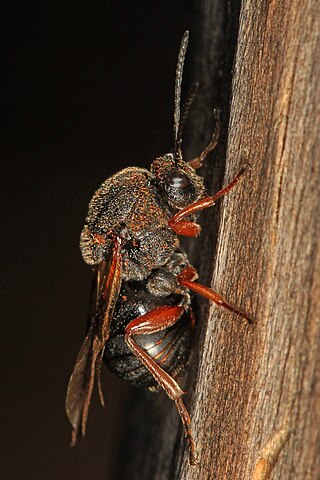
Gall wasps, also traditionally calledgallflies, are hymenopterans of the family Cynipidae in the wasp superfamily Cynipoidea. Their common name comes from the galls they induce on plants for larval development. About 1,300 species of this generally very small creature are known worldwide, with about 360 species of 36 different genera in Europe and some 800 species in North America.

Andricus foecundatrix is a parthenogenetic gall wasp which lays a single egg within a leaf bud, using its ovipositor, to produce a gall known as an oak artichoke gall, oak hop gall, larch-cone gall or hop strobile The gall develops as a chemically induced distortion of leaf axillary or terminal buds on pedunculate oak or sessile oak trees. The larva lives inside a smaller hard casing inside the artichoke and this is released in autumn. The asexual wasp emerges in spring and lays her eggs in the oak catkins. These develop into small oval galls which produce the sexual generation of wasps. A yew artichoke gall caused by the fly Taxomyia taxi also exists, but is unrelated to the oak-borne species. Previous names or synonyms for the species A. fecundator are A. fecundatrix, A. pilosus, A. foecundatrix, A. gemmarum, A. gemmae, A. gemmaequercus, A. gemmaecinaraeformis and A. quercusgemmae.

Andricus is a genus of oak gall wasps in the family Cynipidae.

Cynipini is a tribe of gall wasps. These insects induce galls in plants of the beech and oak family, Fagaceae. They are known commonly as the oak gall wasps. It is the largest cynipid tribe, with about 936 to 1000 recognized species, most of which are associated with oaks. The tribe is mainly native to the Holarctic.
Bassettia is a genus of gall wasps found in North America.
Bassettia pallida is a species of gall wasp found in the Southern United States. This species was described by American entomologist William Harris Ashmead in 1896. B. pallida reproduces asexually in galls it induces on oak trees. The parasite Euderus set, a eulophid wasp, has B. pallida as a host and manipulates its behavior.

Callirhytis is a genus of gall wasps in the family Cynipidae. There are more than 90 described species in Callirhytis. Wasps in this genus primarily induce wasps on oak trees in North America.

Andricus dimorphus, also called the clustered midrib gall wasp, is a species of oak gall wasp in the family Cynipidae. Galls in which the larvae live and feed are formed in clusters along the midrib on the underside of oak leaves.
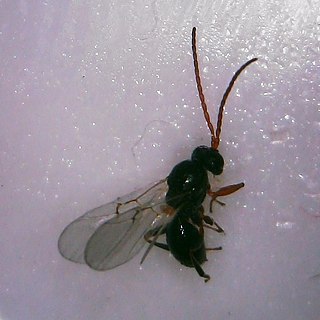
Andricus quercuspetiolicola, also called the oak petiole gall wasp, is a species of oak gall wasp in the family Cynipidae. Galls in which the larvae live and feed are formed along the midrib or petiole of white oak leaves.
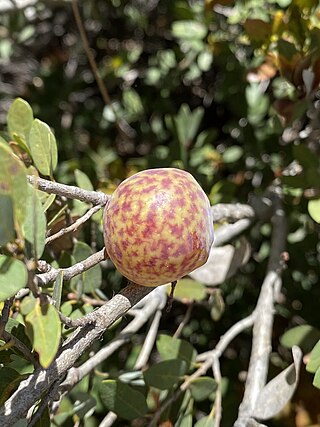
Trichoteras vacciniifoliae, formerly Andricus vacciniifoliae, the golden oak apple wasp, is a species of gall-forming hymenopteran. The wasp creates a stem gall on host plants, namely huckleberry oaks and canyon live oaks. Andricus vacciniifoliae is native to the west coast of North America. Because of their colorful appearance and location on the plant, the galls are often mistaken for fruit. The larval chamber is at the center of the gall, connected to the husk by slender, radiating fibers.

Callirhytis quercusagrifoliae, commonly known as the bud gall wasp, is a species of cypnid wasp that induces galls on the flower buds of coast live oaks and interior live oaks. This wasp has been observed in California in North America.

Callirhytis serricornis, formerly Andricus serricornis, the kernel flower gall wasp, is a species of hymenopteran that produces galls on oak trees in California in North America. The wasp oviposits on coast live oak and interior live oak and induces a gall shaped roughly like a bottle or vase. The gall is brown in the first generation, and red and green in the second.

Trichoteras is a genus of gall-inducing Hymenopteran that has several species formerly classed as Andricus. Trichoteras characteristics include antennae with 10 flagellomeres. An entomologist writing in 2018 stated that "is questionable that Heteroecus and Trichoteras should be synonymized with Andricus" in regard to a proposed taxonomic reorganization of 2002. Ronald A. Russo in Plant Galls of the Western United States moves species like the golden oak apple wasp from Andricus to Trichoteras, while acknowledging the previously accepted binomials. William Harris Ashmead first defined this genus in 1897.

Callirhytis perfoveata, formerly Andricus perfoveata, the leaf ball gall wasp, is a species of hymenopteran that produces leaf galls on oak trees in California in North America. The wasp oviposits on coast live oak, interior live oak, and occasionally on California black oak, and induces what appears to be a roughly spherical gall embedded within the leaf. The gall is initially bright green and turns brown as it ages.
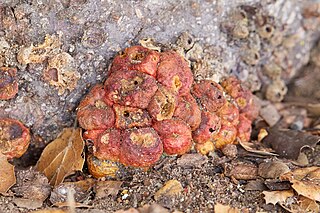
Callirhytis apicalis, formerly Andricus apicalis, the trunk gall wasp, is a species of hymenopteran that induces galls on the trunks or roots of black oak group trees in California in North America. Newly formed galls are red or yellow, turning brown as they age. This wasp is most often associated with Quercus agrifolia. This wasp is generally considered uncommon.

Callirhytis carmelensis, formerly Andricus carmelensis, the mottled acorn gall wasp, is a species of hymenopteran that induces galls on the acorns of coast live oaks and interior live oaks in California in North America. The purple or spotted green gall forms where the acorn attaches to the tree and often prevents normal development of the nut. The gall also produces a honeydew secretion that is attractive to other insects. This wasp is generally considered uncommon.
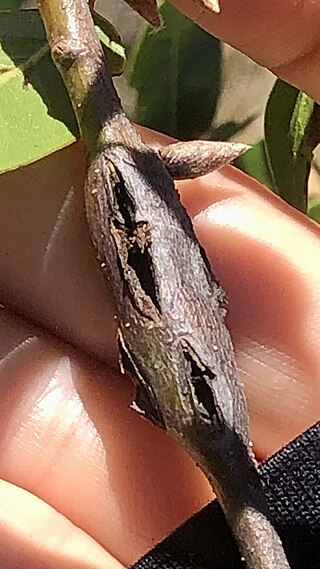
Callirhytis perdens, formerly Andricus perdens, the ruptured twig gall wasp, is a species of hymenopteran that induces integral stem galls on coast live oaks, interior live oaks, and canyon live oaks in California in North America. The wasps oviposit in the stem, and over time, the larval capsules are expelled from the lateral fissures onto the ground, where they either hatch in the leaf litter below the tree, or become fodder for grazing birds and other soil biota. This wasp is considered locally abundant.

Callirhytis eldoradensis, formerly Andricus eldoradensis, the acorn gall wasp, is a species of hymenopteran that induces galls on the acorns of coast live oaks, interior live oaks, and canyon live oaks in California in North America. This gall is not as readily visible as some of the showier oak galls, but exit holes may be visible on the acorns, and galled acorns are likely to stay on the tree after other acorns have dropped. The unisexual generation of this wasp produces a modest bud gall.
















